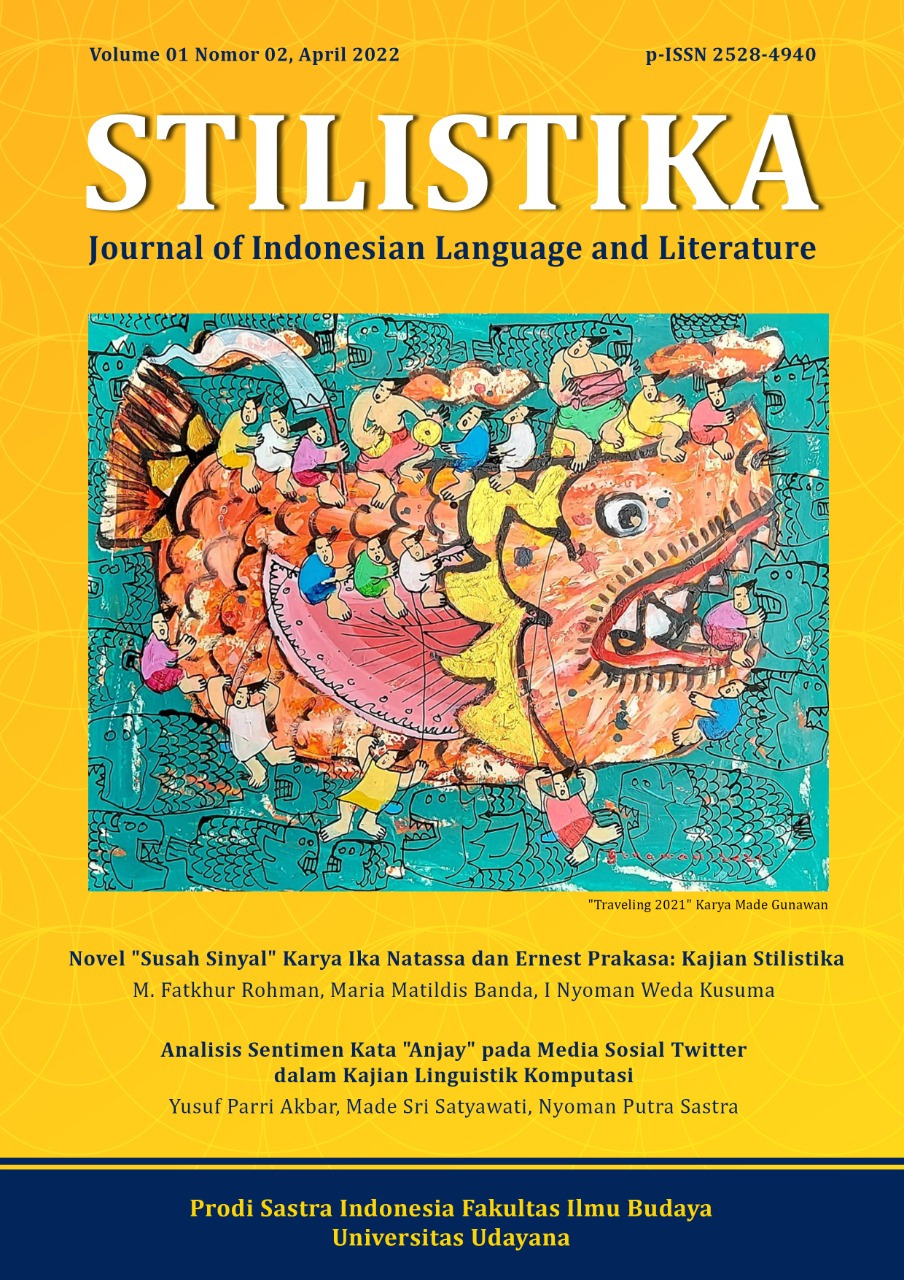Disfemia dalam Kolom Komentar Akun Youtube Najwa Shihab
Abstract
This article examines the use of dysphemia in the comments column of Najwa Shihab's youtube account "Reformation Test". The comment column is a virtual interaction space for netizens. Every netizen can comment in the public space freely. Freedom to comment in the next section leads to the use of dysphemia. Dysphemia is an effort to replace words that mean smooth or ordinary with words that mean rude. There are two problem formulations in this article. 1) what is the form of dysphemia in the comment column of Najwa Shihab's youtube account "Reformation Test" 2) what are the characteristics of hate speech in the column Comments on Najwa Shihab's youtube account "Reformation Test" in terms of the use of dysphemia. The theory used is semantic theory, especially dysphemia. Data collection is carried out by the listening method, free to engage in conversation. Data analysis is carried out using the agih method with the determining element sorting technique (PUP). Presentation analysis results are presented informally and formally. The results of the 70 data showed that the use of dysphemia was dominated by the word form with 36 data. Dysphemia in the form of 26 data phrases, then 2 data in the form of clause dysphemia. The last 6 data form of sentence dysphemia. The existence of this form of dysphemia is intended to sharpen and strengthen the meaning in the commentary aspect. The characteristics of hate speech in the comments column of Najwa Shihab's youtube account "Reformation Test" in terms of the use of dysphemia are divided into four characteristics, namely insults, defamation, provocation, and unpleasant actions.
Downloads
References
Allan, Keith. 1991. Euphemism dan Dysphemism Language Used As Shield an Weapons . London: United States Of London Oxford University Press.
Aminuddin. 2001. Semantik Pengantar Studi Tentang Makna. Bandung: Sinar Baru Algensindo.
Chaer, Abdul. (2010). Sosiolingiustik: Perkenalan Awal. Jakarta: Rineka Cipta.
Chaer, Abdul. 1990. Pengantar Semantik Bahasa Indonesia. Jakarta: Rineka Cipta.
Chaer, Abdul, 2007. Linguistik Umum. Jakarta: Rineka Cipta.
Departemen Pendidikan Nasional. 2002. Kamus Besar Bahasa Indonesia (KBBI).Jakarta: Pusat Bahasa.
Djajasudarma, T. Fatimah. 2006. Metode Linguitik:Rancangan Metode Penelitian dan Kajian. Bandung: Eresco.
Hardiyanto. 2008. Leksikologi Sebuah Pengantar. Yogyakarta: Kanwa Publisher.
Kridalaksana, Harimurti. 1983. Kamus Linguistik. Jakarta: PT. Gramedia.
Lestari. 2013. “Disfemia dalam Rubrik Bola Nasional pada Tabloid Bola”. Skripsi. Prodi Bahasa dan Sastra Indonesia Fakultas Bahasa dan Seni Universitas Negeri Yogyakarta: Yogyakarta.
Moloeng, L. J. 2007. Metodologi Penelitian Kualitatif. Bandung: PT Remaja Rosda.
Muhadjir, Noeng, 2000, “Metode Penelitian Kualitatif, Jogja: Rake Sarasin.
Rahmita.2008. Tindak Tutur Ekspresif Pada Wacana Ruprik Sms Anda Tabloid Cempaka”. Skripsi Universitas Negeri Semarang: Semarang.
Pateda, Mansoer. 2001. Semantik Leksikal. Jakarta: Rineka Cipta.
Prasetyo, 2018. “Disfemia Dalam Kolom Komentar Warganet Di Line Today ”. Skripsi. Universitas Negeri Program Studi Sastra Indonesia Fakultas Bahasa Dan Seni: Jakarta.
Santoso, Joko. 2003. Semantik. Diktat. Yogyakarta: Fakultas Bahasa dan Seni UNY.
Sudaryanto. 1993. Metode dan Aneka Teknik Analisis Bahasa (Pengantar Penelitian Wahana Kebudayaan Secara Linguistis). Yogyakarta: Duta Wacana University Press.
Sudaryanto. 1993. Metode dan Aneka Teknik Analisis Bahasa: Pengantar Penelitian Wahana Kebudayaan Secara Linguistik. Yogyakarta: Duta Wacana University Press.
Tarigan, Henry Guntur. 1985. Pengajaran Semantik. Bandung: Angkasa.
Verhaar,J. W. M. 2008. Asas-Asas Linguistik Umum. Yogyakarta: Gadjah Mada.
Zaim. M. 2014. Metode Penelitian Bahasa: Pendekatan Struktural. Padang: Sukabina Press Padang.
Sumber Internet
Erlinawati. 2017. “Penggunaan Disfemia Dalam Kolom Komentar Para netizen Di Situs Online Kompas.com Pada rubrik Politik”. Skripsi. https://eprints.uny.ac.id/. Diakses 2 Agustus 2020.






